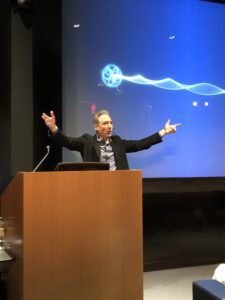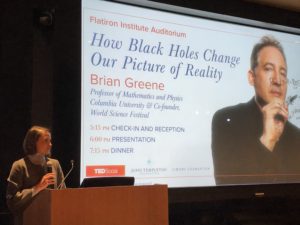New York, NY — Just hours after Templeton-backed researchers unveiled the first-ever picture of a black hole, renowned physicist Brian Greene appeared at a Foundation-sponsored event to discuss how black holes are revolutionizing our understanding of reality.
“Black holes provide a number of theoretical puzzles that we are still trying to resolve,” said Greene, professor of mathematics and physics at Columbia University and co-founder of the World Science Festival.
The TED Social event, “How Black Holes Change Our Picture of Reality,” was organized jointly by the John Templeton Foundation and Simons Foundation and brought together dozens of science-interested members from the TED network, including philanthropists, journalists, entrepreneurs, and practicing scientists.
 Greene, the keynote speaker, gave an hourlong lecture in which he presented a dazzling series of ideas derived from black hole physics, including wormholes, the holographic principle, and the implications of quantum entanglement for black holes.
Greene, the keynote speaker, gave an hourlong lecture in which he presented a dazzling series of ideas derived from black hole physics, including wormholes, the holographic principle, and the implications of quantum entanglement for black holes.
Such fertile theoretical activity “shows how much opportunity there is going forward to rewrite our understanding of reality,” he said.
“It could be that someday we may have a full answer to, what is space? What is it made of? How does it hold together? And I suspect that those answers will rely on these insights that come from black hole physics.”

Heather Templeton Dill introduces Brian Greene at the John Templeton Foundation sponsored April 10 TEDSocial event in New York.
In her welcome address for Greene, John Templeton Foundation president Heather Templeton Dill said that the groundbreaking image of a black hole released April 10 reminds us of “the limitless potential of the sciences to help us better understand our world.”
Such breakthroughs, she added, fulfill the mission of the Foundation to support research that sheds light on unseen realities, including fundamental structures of the universe. Moreover, it builds on a legacy of significant work in the natural sciences funded by the Foundation, including projects such as:
- Cosmic microwave background research leading up to the detection of gravitational waves in 2017 through the POLARBEAR and BICEP teams;
- Research on cause-effect structures in quantum systems, as well as investigations of quantum hardness and quantum gravity;
- Astronomers’ search for planets outside our solar system, including those capable of harboring life;
- Experiments on the human microbiome to expand understanding of how complex networks might be predicted and controlled.
The event took place at the auditorium of the Simons Foundation’s Flatiron Institute. Launched in 2016, the Institute conducts scientific research in-house, supporting teams of top computational scientists. The Simons Foundation exists to support basic – or discovery-driven – scientific research undertaken in the pursuit of understanding the phenomena of our world.